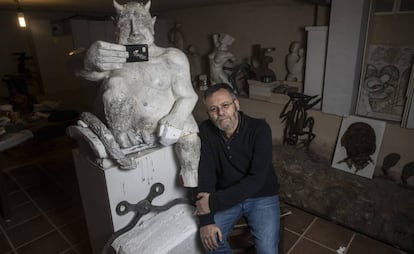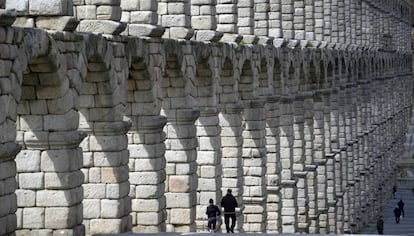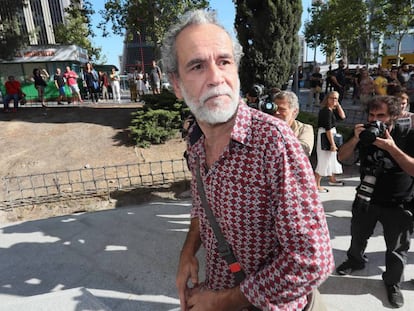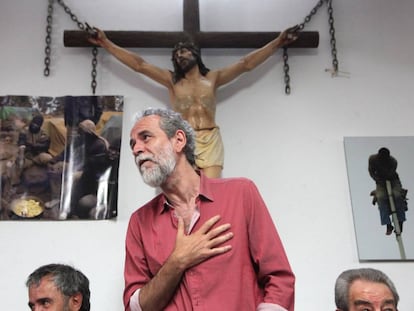How a selfie-snapping statue of the devil has raised the ire of Segovia locals
The actions of a group of residents in the city have prompted a judge to halt the installation of the image of Mephistopheles, which was designed to appeal to tourists

Millennia after having been built, the stunning aqueduct in the Spanish city of Segovia continues to be a source of news. This time, the story is related to one of its myths. According to an old story, the bridge was not built by the Romans, but by Mephistopheles himself, having been swindled by a young Segovian to raise the aqueduct in a single night.
I just can’t believe that this could happen in 21st-century Spain Claudia de Santos, responsible for Segovia heritage
In order to convey this story to the more than 800,000 tourists who visit the city – located north of Madrid – every year, the local council has decided to erect a statue of a devil there. But the move has brought controversy with it: the complaints from local residents have seen the installation work halted by a judge.
The 1.7-meter sculpture depicts a smiling devil, who has a cellphone in one hand and is taking a selfie. The idea is to attract tourists, given their habit of posting pictures of their trips on social networks. But the final installation will have to wait until a Segovia court rules whether the statue constitutes an attack on religious sentiments, as a group of local residents have denounced.
The objective of the statue is, above all else, to create new flows of tourists in the city, given that Segovia receives a huge number of visitors, all of whom tend to congregate in a few streets in the old quarter. “If the sculpture works, there will be more people in the area of the north wall, which is also very important for Segovia, but less visited than the areas around the aqueduct,” explains Claudia de Santos, who is in charge of the city’s heritage.

“It all began with a visit to Lübeck,” explains José Antonio Abella, the creator and donator of the statue. “They also have a local legend about the devil being duped into building a church. When I saw the little figure they had there as a tribute, I thought, ‘What a great idea to export to Segovia!’”
A sculptor and a writer, the retired country doctor was born in Burgos 63 years ago, but says that he is Segovian by adoption. The row that has broken out over his creation has taken him by surprise. “I don’t understand anything,” he says, with sadness. “I just wanted to pay homage to my city and to create something to give back all I have been given.”
The devil is offensive for Catholics, because it constitutes the glorification of evil
Petition against sculpture
Two natives of the city, Marta Jerez and Esther Lázaro, have founded the San Miguel and San Frutos Association, with the aim of stopping the statue from being installed. According to their petition on campaigning website change.org, which already has more than 5,000 signatures, the devil “is offensive for Catholics, because it constitutes the glorification of evil.” What’s more, his smiling expression makes things worse, according to the association, because it “represents the devil alone, making him the protagonist, without being next to a church, nor in any other environment that reflects the rejection of this figure.”
For De Santos, the association merely represents just “a few people,” and she says that the project will go ahead in the face of a situation she considers to be “unfair and disheartening.” “I just can’t believe that this could happen in 21st-century Spain,” she complains, adding that the association has gone so far as to say that “Segovia is going to become a focal point for satanic worship.”
“It’s insane,” adds sculptor José Antonio Abella, who points out with a hint of irony that this Mephistopheles is going to be installed next to the former headquarters of the Spanish Inquisition in the city. “It would appear that the inquisitors never left the country for good,” he concludes.
English version by Simon Hunter.
Tu suscripción se está usando en otro dispositivo
¿Quieres añadir otro usuario a tu suscripción?
Si continúas leyendo en este dispositivo, no se podrá leer en el otro.
FlechaTu suscripción se está usando en otro dispositivo y solo puedes acceder a EL PAÍS desde un dispositivo a la vez.
Si quieres compartir tu cuenta, cambia tu suscripción a la modalidad Premium, así podrás añadir otro usuario. Cada uno accederá con su propia cuenta de email, lo que os permitirá personalizar vuestra experiencia en EL PAÍS.
¿Tienes una suscripción de empresa? Accede aquí para contratar más cuentas.
En el caso de no saber quién está usando tu cuenta, te recomendamos cambiar tu contraseña aquí.
Si decides continuar compartiendo tu cuenta, este mensaje se mostrará en tu dispositivo y en el de la otra persona que está usando tu cuenta de forma indefinida, afectando a tu experiencia de lectura. Puedes consultar aquí los términos y condiciones de la suscripción digital.
More information
Archived In
Últimas noticias
From digital curfews to blocking apps: How technology experts protect their children online
Why the price of coffee has skyrocketed: from Brazilian plantations to specialty coffee houses
Confined to a Cuban hospital: When electricity is a matter of life or death
How Japan is trying to avert ‘digital defeat’
Most viewed
- Pablo Escobar’s hippos: A serious environmental problem, 40 years on
- Reinhard Genzel, Nobel laureate in physics: ‘One-minute videos will never give you the truth’
- Why we lost the habit of sleeping in two segments and how that changed our sense of time
- Charles Dubouloz, mountaineering star, retires at 36 with a farewell tour inspired by Walter Bonatti
- The Florida Keys tourist paradise is besieged by immigration agents: ‘We’ve never seen anything like this’










































